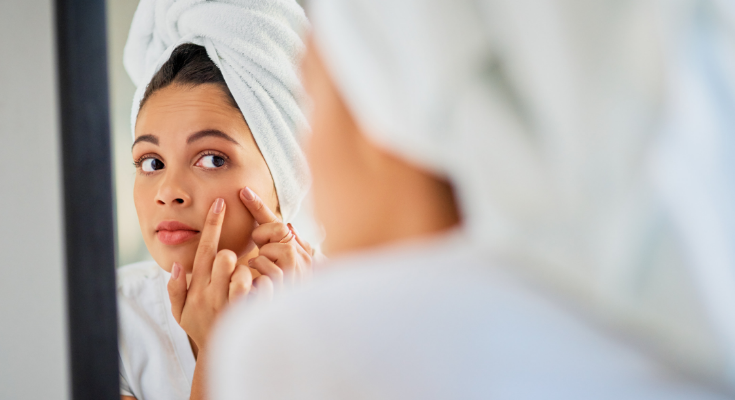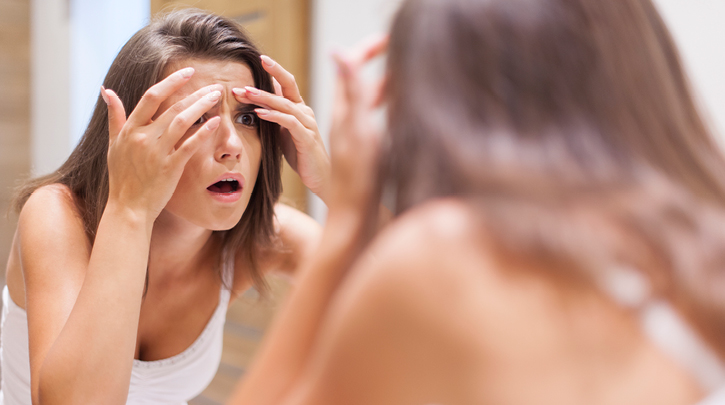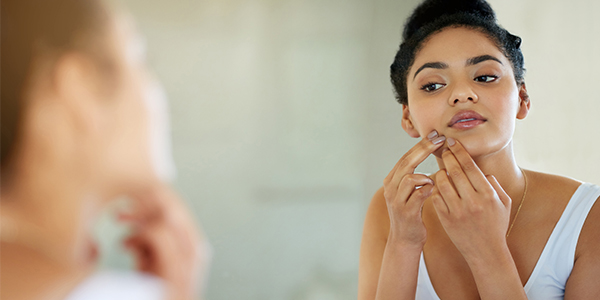




Acne can be a stressful cycle to break. It takes plenty of patience to keep up with acne treatment routines, restrain from picking, and allow time for each treatment to kick into action. It can all get even more irritating when your efforts seem to simply end up in more acne breakouts. Instead of another list of all the things you should do to beat the breakouts, we’re focusing in on the mistakes you may be making when you’re trying to get rid of pimples, zits, and acne-related inflammation, so you can keep working toward a treatment routine that works for you without your habits potentially undermining its effectiveness.
Using a spot treatment to try and zap zits once they pop up is a sure-fire losing game. Spot treatments can be useful in taming inflammation and potentially helping to loosen clogged pores, but oftentimes, when you see one pimple, there are others forming in the area. Further, by using acne-fighting skin care products only when you see a breakout, skin is unable to adapt to your routine and the active ingredients in each product, causing stress, irritation, and dryness that just intensifies the acne cycle. Rather than springing into action once a breakout surfaces, opt for a gentler, regular acne-fighting skin treatment that can help to heal current breakouts and prevent future ones. This way, your skin can adapt to and fully benefit from its acne-fighting effects.
It may feel natural to avoid using exfoliators on acne-prone skin to avoid causing irritation, but this instinct is a major mistake. Consider exfoliating your key first step in acne prevention. You’ll want to avoid harsh skin care exfoliators that contain larger scrubbing elements—think sugars, salt, or other physical scrubbers—and opt instead for an acid-based exfoliator to help remove dead skin cells that are clogging pores and causing your breakouts in the first place. When first incorporating an acid-based exfoliator into your at-home acne treatment routine, choose a product that contains a lower concentration of acid and work your way up, depending on how your skin reacts, to avoid irritation. If you need some guidance in choosing the right product for you, a dermatologist or aesthetics treatment provider can point you in the right direction of an effective product and concentration for your skin.
While there are many active ingredients that fight acne, you may not know that they fight different types of acne. Using the wrong active ingredient for the type of acne you’re experiencing can either have no effect at all or it could make matters worse. For this reason, it’s best to first identify what type(s) of acne you’re looking to treat, then consider the best product for the job. For starters, benzoyl peroxide is primarily an antimicrobial, meaning it works by eliminating acne-causing bacteria and is best paired with papules and pustules that are linked to higher levels of bacteria. If you’re experiencing comedones (small blackheads or whiteheads), salicylic acid is more likely to do the trick. As an exfoliator, salicylic acid removes dead skin to prevent the further formation of comedones, which most often result from dead skin clogging pores.
We’re all eager to see instant results, particularly when it comes to treating acne. Unfortunately, even those products that claim overnight results are promoting unrealistic expectations. Some treatments may be able to reduce inflammation and redness in a shorter timeframe, but they can’t resolve acne that quickly. Acne treatments take time to do their magic. Switching it up too often will only cause further skin irritation, which restarts the acne cycle. Rather than quickly ditching a treatment that doesn’t afford instant results, use each acne product for at least six to eight weeks. This will allow its full effects to take hold and skin cell renewal to properly occur, allowing you to better judge if it’s the right product for you and your skin. If it’s not working within that six-to-eight-week period, then you may move on to a new acne treatment or add another product to your routine to amplify the effects. Further, once your acne clears up, skin care experts recommend keeping up the routine to prevent any future breakouts. Essentially, slow and steady is the name of the acne-fighting game.
You might be tempted to frequently cleanse your skin to strip away all potential traces of bacteria and excess oils, but that’s a major error. Abusing your acne treatments by cleansing too much strips the skin of its natural oils and leads to dry, dehydrated skin that will only cause further breakouts. Further still, your skin may attempt to counteract dryness by producing even more oil. Instead of excessively cleansing skin with harsh cleansers or ingredients, keep natural oils in place by ensuring you’re still moisturizing your skin and don’t fall for the notion that a higher concentration of an active ingredient will lead to better, faster results. In fact, studies suggest that higher concentrations of the active ingredient benzoyl peroxide offer no additional effects on acne breakouts and may cause further skin irritation, meaning a lower concentration may be the better choice.
Sure, it might seem like common sense that the best acne-fighting solutions live in the skin care aisle at our local beauty or drugstores, but by only relying on topical products, you may be missing out on a potentially gentler, more effective option. To treat stubborn acne and end the breakout cycle, you may want to venture to a nearby aesthetics clinic and consider supercharging your acne-fighting skin care routine with customized Venus Versa™ acne reduction treatments. Utilizing Intense Pulsed Light (IPL) technology, these dual-light treatments effectively target and destroy acne-causing Propionibacterium acnes (P. acnes) bacteria while reducing acne-related redness and inflammation for faster healing and breakout prevention. Treatments are safe to use alongside an acne-fighting skin care routine, although it can depend on the specific products. It’s always best to consult with your treatment provider to ensure you’re using the most effective products and treatments for your skin.
Interested in learning more about Venus Versa™ acne reduction treatments and whether they’re the right solution for you? Locate a certified treatment provider near you using the search field below for a consultation and customized treatment plan.
Find a certified Venus Treatments provider near you today who specializes in today’s top aesthetic medical solutions.



Search below to find a provider near you and to learn about our non-surgical aesthetic treatments with ARTAS®, NeoGraft®, Venus Bliss™, Venus Versa™, Venus Legacy™, Venus Velocity™, Venus Viva™ MD, Venus Freeze Plus™, and Venus Glow™.
For more information call: +61 416 022 096 // [email protected] // Suite 3.06/ Level 3 20 Rodbourgh Road, Frenchs Forest NSW 2086, Australia
REGULATORY CLEARANCES [ More ]
Venus Versa™ has CE Mark as a multi-application device intended to be used in aesthetic and cosmetic procedures. The SR515 and SR580 applicators have CE Mark for the treatment of benign pigmented epidermal and cutaneous lesions and treatment of benign cutaneous vascular lesions. The HR650/HR650XL and HR690/HR690XL applicators have CE Mark for the removal of unwanted hair and to effect stable long-term or permanent hair reduction for Fitzpatrick skin types I-IV. The AC Dual applicator has CE Mark for the treatment of acne vulgaris. The DiamondPolar™ applicator has CE Mark for non-invasive treatment of moderate to severe facial wrinkles and rhytides on females with Fitzpatrick skin types I-IV. The OctiPolar™ applicator on the Venus Versa™ system has CE Mark for temporary body contouring via skin tightening, circumferential reduction, and cellulite reduction. The NanoFractional RF™ (Viva) applicator has CE Mark for dermatological procedures requiring ablation and resurfacing of the skin.
NeoGraft® 2.0 has CE Mark and TGA with indication for use in suction-assisted follicular extraction and re-implantation for males and females.
The ARTAS iX™ from Restoration Robotics® is indicated for harvesting hair follicles from the scalp in men diagnosed with androgenic alopecia (male pattern hair loss) who have black or brown straight hair. The ARTAS iX™ from Restoration Robotics® is intended to assist physicians in identifying and extracting hair follicular units from the scalp during hair transplantation; creating recipient sites; and implanting harvested hair follicles.
Venus Epileve™ has CE Mark for hair removal, permanent hair reduction (defined as the long-term stable reduction in the number of hairs re-growing when measured at 6, 9 and 12 months after the completion of a treatment regimen), and the treatment of pseudofolliculitis barbae for all Fitzpatrick skin types. Venus Epileve™ is also CE-Marked for hirsutism.
Venus Legacy™ has CE Mark for the temporary increase of skin tightening, circumferential reduction, cellulite reduction, and wrinkle reduction.
Venus Velocity™ has CE Mark for hair removal, permanent hair reduction (defined as the long-term stable reduction in the number of hairs re-growing when measured at 6, 9 and 12 months after the completion of a treatment regimen), and the treatment of pseudofolliculitis barbae for all Fitzpatrick skin types.
Venus Viva™ has CE Mark for the use in dermatologic and general surgical procedures requiring ablation and resurfacing of the skin, and the treatment of moderate to severe facial wrinkles and rhytides in Fitzpatrick skin types I-IV with the DiamondPolar™ applicator.
Venus Freeze Plus™ has CE Mark for treatment of moderate to severe facial wrinkles and rhytides using the DiamondPolar™ applicator, and CE Mark for the treatment of cellulite reduction, increase of skin tightening, and temporary circumferential reduction on the OctiPolar™ applicator.
Venus Freeze™ has CE Mark for treatment of moderate to severe facial wrinkles and rhytides using the DiamondPolar™ applicator, and CE Mark for the treatment of cellulite reduction, increase of skin tightening, and temporary circumferential reduction on the OctiPolar™ applicator.
Venus Glow™ provides a dermal rejuvenation treatment that works to open up and deep-clean pores. Venus Concept is the exclusive distributor for Venus Glow™.
Copyright © 2023 Venus Concept. All rights reserved.
You are entering our website. For other country/regions and language options, please click the button below.
Click HereAre you a physician or aesthetician? Please visit our medical and aesthetic professional website to learn more.
Click Here